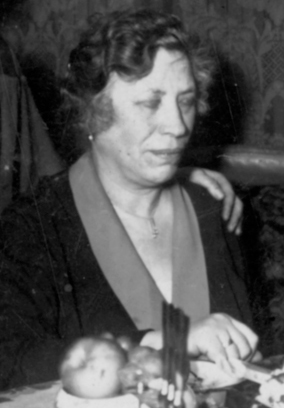Search for Names, Places and Biographies
Already layed Stumbling Stones
Suche
Toni Neufeld (née Katzenstein) * 1867
Neue Straße 52 (Harburg, Harburg)
HIER WOHNTE
TONI NEUFELD
GEB. KATZENSTEIN
JG. 1867
DEPORTIERT 1942
THERESIENSTADT
ERMORDET IN
TREBLINKA
further stumbling stones in Neue Straße 52:
Selma Wolff
Toni Neufeld, née Katzenstein, born on 20 Dec. 1867 in Harburg, deported on 15 July 1942 to Theresienstadt, deported further on 21 Sept. 1942 to Treblinka, murdered
Harburg-Altstadt quarter, Neue Strasse 52
Toni Katzenstein was the sixth child of her Jewish parents Jacob (1834–1895) and Friederike Katzenstein, née Freudenthal (1836–1908), who had married in Harburg on 16 June 1858. The five older siblings of Toni Katzenstein were joined by six younger ones. As a produce trader (Produktenhändler), Jacob Katzenstein must not have had an easy time feeding this bunch of children. The Katzensteins lived together with three other families in a house at Neue Strasse 52, in the immediate vicinity of the Lutheran Trinity Church, the Harburg City Church, built in 1652. We know nothing more about Toni’s childhood and adolescence.
As a young woman, Toni Katzenstein married the Jewish tobacco and cigar dealer Siegfried Neufeld (born on 30 Dec. 1868). The married spouses became members of the Hamburg German-Israelitic Community. In the following years, they changed their private and business addresses surprisingly often for reasons unknown.
Their daughter Erna was born on 8 Nov. 1897 and their son Herbert on 20 Dec. 1902.
The family’s financial situation was anything but rosy. Business did not always go as Siegfried Neufeld would have liked. Few carefree times were followed by extended lean periods. The financial problems grew during the years of the world economic crisis. In 1929, they became unsolvable for Siegfried Neufeld. He had to admit failure.
The business was taken over by his son, whose hopeful new beginning soon came to a standstill when the Nazis assumed power. He left the business to his sister, who was no longer able to stop the declining development in view of the increasing state-driven displacement of the Jews from German economic life.
On 1 Feb. 1934, Toni Neufeld became the owner of the highly indebted tobacco and cigar shop in Hamburg’s historic downtown. However, even she could not turn the tide. The task became even more difficult for her when her husband died on 25 Sept. 1935 at the age of 66. On 30 Mar. 1937, she handed over the business to a successor due to "her old age and the changed situation on the market.”
She could not fall back on substantial savings. They were so small that she did not have to pay any Jewish religious tax (Kultussteuer), and when the last reserves were exhausted, Toni Neufeld even had to turn to the welfare office of the Jewish Community.
Even her children Erna Dobriner, née Neufeld, and Herbert Neufeld could not stop this sharp social decline. After the November Pogrom of 1938, they had left their homeland in a hurry without any means, seeking refuge in Britain and Bolivia. A little later, they helplessly heard the news that their elderly mother had to vacate her accommodation as a subtenant at Grindelallee 9 and move to the Jewish residential home at Bundesstrasse 35.
This house was once built in the nineteenth century by the Samuel Levy Foundation to provide free housing for "righteous, peace-loving, and needy” members of the German-Israelite and Portuguese communities. The applicants had to have exceeded the age of 50. In 1909, there were 25 two-room apartments with kitchen and 22 one-room apartments with kitchen in the house. After 1933, the growing housing shortage of the Jews also became noticeable in this house. The increasing demand required an ever-stricter regulation of the allocation of living space. On 1 Jan. 1941, 105 people lived in the residential home, and in July 1942, that number was more than 130.
On 15 July 1942, 104 residents of this residential home alone were deported to the Theresienstadt "ghetto for the elderly” ("Altersgetto”). One of them was Toni Neufeld. In the following weeks and months, one transport after the other arrived at this place where about 7,000 people had lived before the Second World War. In Sept. 1942 alone, the number of residents who had to be newly accommodated increased by 18,693. More than 13,000 of these people were further deported to the Nazi extermination camps in the East over the coming weeks and months.
For Toni Neufeld, too, Theresienstadt was only a transit station on the journey to death. On 21 Sept. 1942, she was taken to the Treblinka extermination camp together with over 2,000 other persons and murdered there.
Her sisters Henny Andrade and Selma Wolff did not survive the Holocaust either (see www.stolpersteine-hamburg.de).
Translator: Erwin Fink
Kindly supported by the Hermann Reemtsma Stiftung, Hamburg.
Stand: June 2020
© Klaus Möller
Quellen: Staatsarchiv Hamburg, 992b Kultussteuerkartei der Deutsch-Israelitischen Gemeinde Hamburg, 351-11_1197, 351-11_48084, 351-11_44520, 351-11_26675, Amt für Wiedergutmachung, 332-5 Standesämter; Harburger Adressbücher; Hamburger jüdische Opfer des Nationalsozialismus. Gedenkbuch, Jürgen Sielemann, Paul Flamme (Hrsg.), Hamburg 1995; Theresienstädter Gedenkbuch. Die Opfer der Judentransporte aus Deutschland nach Theresienstadt 1942–1945, Prag 2000; Yad Vashem. The Central Database of Shoa Victims´ Names: www.yadvashem.org; Gedenkbuch. Opfer der Verfolgung der Juden unter der nationalsozialistischen Gewaltherrschaft in Deutschland 1933–1945, Bundesarchiv (Hrsg.), Koblenz 2006; Harburger Opfer des Nationalsozialismus, Bezirksamt Harburg (Hrsg.), Hamburg 2003; Alfred Gottwald, Diana Schulle, Die `Judendeportationen´ aus dem Deutschen Reich 1941–1945, Wiesbaden 2005; Matthias Heyl, Vielleicht steht die Synagoge noch. Ein virtuelles Museum zur Geschichte der Harburger Juden, CD-ROM, Hamburg 1999; Wegweiser zu den ehemaligen Stätten jüdischen Lebens oder Leidens in Hamburg, Heft 2, Deutsch-Jüdische Gesellschaft Hamburg (Hrsg.), Hamburg 1985.


